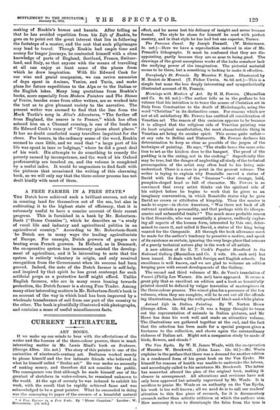Mornings with Masters of Art. By H. H. Powers. (Macmillan
and Co. 8s. 6d. net.)—The author tells us in the preface to his volume that his intention is to trace the course of Christian art in Italy from Constantine to the death of Michelangelo, using the word "Christian" in its distinctive sense. For reasons which are not at all satisfactory Mr. Powers has omitted all consideration of Venetian art. The reason of this omission appears to be because it is alleged that the religious side of Venetian painting was its least original manifestation, the most characteristic thing in Venetian art being its secular spirit. This seems quite unfair— at any rate to Bellini and Tintoretto. Mr. Powers declares his determination to keep as clear as possible of the jargon of the technique of painting. He says, "The studio bears the same rela- tion to art as tho kitchen does to the banquet. The proof of tho pudding is in the eating, not in the cooking." Superficially this may be true, but the danger of neglecting all study of the technical preoccupation of the artist may often lead to his being mis- understood. There is a case in point in the present volume. The writer is trying to explain why Donatello carved a statue of David with the form of the " Zuccone "—that strange, bald, pumpkin-shaped head so full of character. Mr. Powers is so convinced that every artist thinks out the spiritual side of his subject before ho begins to work that he gives us an imaginary conversation, in which Donatello states why he gave David no crown or attributes of kingship. Thus the master is made to argue—in choice American, " Was there not back of all outward symbols a personality, and that perhaps with its idiosyn- crasies and nnbeautiful traits ?" The much more probable reason is that Donatello, who was essentially a pioneer, endlessly captor- ing all aspects of the human form, interested by this one, deter- mined to carve it, and called it David, a statue of the king being wanted for the Campanile. All through the book allowance must be made for the author's tendency to perceive a motive, and speak of its existence as certain, ignoring the very large place that reasons of a purely technical nature play in the work of all artists.


























































 Previous page
Previous page